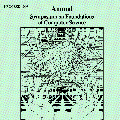In the classic longest common substring (LCS) problem, we are given two strings $S$ and $T$, each of length at most $n$, over an alphabet of size $\sigma$, and we are asked to find a longest string occurring as a fragment of both $S$ and $T$. Weiner, in his seminal paper that introduced the suffix tree, presented an $\mathcal{O}(n \log \sigma)$-time algorithm for this problem [SWAT 1973]. For polynomially-bounded integer alphabets, the linear-time construction of suffix trees by Farach yielded an $\mathcal{O}(n)$-time algorithm for the LCS problem [FOCS 1997]. However, for small alphabets, this is not necessarily optimal for the LCS problem in the word RAM model of computation, in which the strings can be stored in $\mathcal{O}(n \log \sigma/\log n )$ space and read in $\mathcal{O}(n \log \sigma/\log n )$ time. We show that, in this model, we can compute an LCS in time $\mathcal{O}(n \log \sigma / \sqrt{\log n})$, which is sublinear in $n$ if $\sigma=2^{o(\sqrt{\log n})}$ (in particular, if $\sigma=\mathcal{O}(1)$), using optimal space $\mathcal{O}(n \log \sigma/\log n)$. We then lift our ideas to the problem of computing a $k$-mismatch LCS, which has received considerable attention in recent years. In this problem, the aim is to compute a longest substring of $S$ that occurs in $T$ with at most $k$ mismatches. Thankachan et al.~showed how to compute a $k$-mismatch LCS in $\mathcal{O}(n \log^k n)$ time for $k=\mathcal{O}(1)$ [J. Comput. Biol. 2016]. We show an $\mathcal{O}(n \log^{k-1/2} n)$-time algorithm, for any constant $k>0$ and irrespective of the alphabet size, using $\mathcal{O}(n)$ space as the previous approaches. We thus notably break through the well-known $n \log^k n$ barrier, which stems from a recursive heavy-path decomposition technique that was first introduced in the seminal paper of Cole et al. [STOC 2004] for string indexing with $k$ errors.
翻译:在经典最长期的常见子串( LCS) 问题中, 我们得到两个字符串 $和$T$, 以美元计, 以美元计, 以美元计, 以美元计, 要求我们找到一个最长的字符串, 以美元计, 以美元计, 以美元计。 Weiner, 在他的引入后缀树的原始文件中, 提出了一个 $\ mathal{ O} (n\log\ sgma) 时间算法, 以美元计 [SWAT 1973] 。 对于以美元计的单调整型字母, 以美元计, 以美元计, 以美元计, 以美元计, 以美元计, 以美元计 。 然而, 对于小字母算来说, 这不一定是最佳的 LCS&AM 模型问题, 以美元计, 以美元计时值计。





